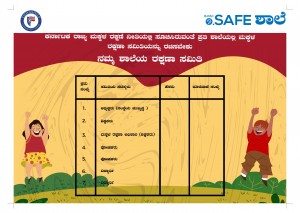Child Protection Policy
Safety of children is one key issue facing the country. Safe schools play a vital role in building a safe environment for children. The Karnataka Government has introduced the Child Protection Policy to help combat this very issue. However, the challenge is to build greater awareness and create larger community engagement to ensure the implementation of this policy.
As per the policy, the initial steps that the school must undertake to implement the policy are:
- Self-assess the school as per the checklist mentioned in the Child Protection Policy and work towards meeting all the mandatory safety requirements.
- Set up a Child Protection Committee (with 2 teachers, 2 parents and 2 students) and appoint a Child Protection Officer. The committee’s core responsibility is to review the monitoring process of Child Protection Policy at the school.
- Draft a Child Protection Policy for the school
You may give Safety Kits for schools:
- A checklist to measure safety parameters at schools and analyse the current gaps that need to be addressed
- Guidelines to form Child Protection Committee
- Copy of Karnataka State Child Protection Policy
- Safety charts with helpline/emergency numbers
- The Child Protection Policy expands on due diligence required during staff recruitment, a general template to report any undue-incidents etc.
Steps to implement:
- Visit the school
- Help schools form the Child Protection Committee (CPC)
- Put up safety charts in schools and make children aware of helpline and emergency numbers.
- Find out and fill all the local relevant contact numbers which would be required in case of emergency (local police station, local primary health care centre/hospital, Child Welfare Officer etc.)



